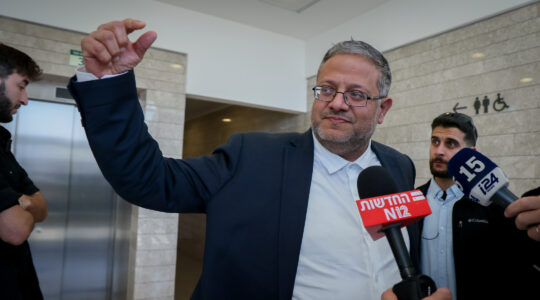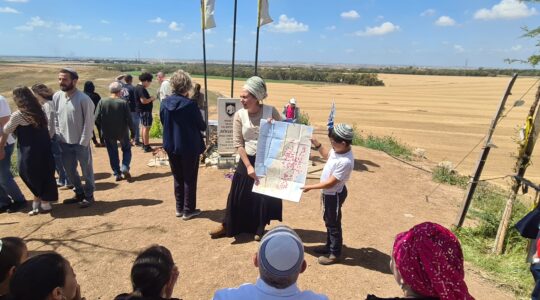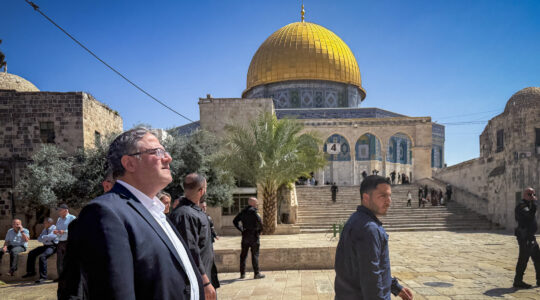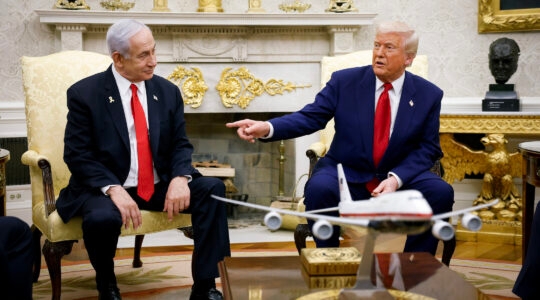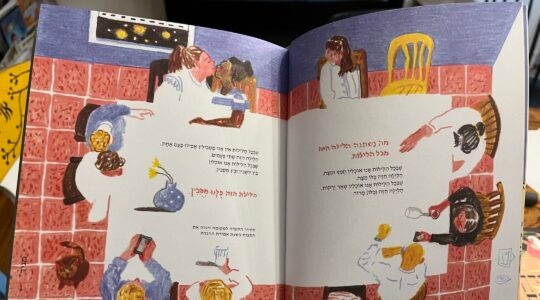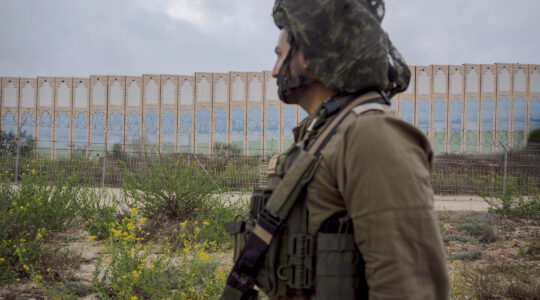
A framed photograph of Yevgenia Dorfman, 15, who was killed in a suicide bombing at the Tel Aviv’s seaside Dolphinarium disco, rests on a rock along the beach just south of where the attack took place 10 years ago. (Dina Kraft)
TEL AVIV, Israel (JTA) — Faina Dorfman, who immigrated to Israel from Uzbekistan hoping that her only child would have a better life here, walks along a stretch of beach just south of a tattered seaside disco called the Dolphinarium.
Ten years ago, a young Palestinian detonated a bomb packed with nails and bullets as he stood amid a crowd waiting to be let inside for a night of dancing.
The suicide bomber stole away the life of Dorfman’s 15-year-old daughter, Yevgenia (known as Genya), along with the lives of 20 others, most of them teenage immigrants from the former Soviet Union.
“The world is a crazy place where people kill each other and never learn,” said Dorfman, a strong sea breeze blowing as she spoke. “Like everyone else, I never thought this madness would reach me, my family.”
The June 1, 2001 attack, which also wounded more than 100, would become seared into the Israeli consciousness as one of the most infamous of the second Intifada.
For Russian-speaking immigrants, the bombing marked an initiation to the reality of the Israeli-Palestinian conflict that would bring them into the fold of Israeli society in the most painful of ways.
“It was seen as sort of a right of passage as it is described in anthropological terms,” said Larissa Remennick, a professor of sociology at Bar-Ilan University. “To become one of ‘us’ is to demonstrate participation in a national log of losses, that you too have paid a toll.
“Despite the terrible nature of this tragedy, the Russian community, if it can be called a community, was kind of christened in blood together,” said Remennick, whose research focuses on Russian Jewish immigrants around the world.
In the 10 years since, Russian-speaking immigrants have gone on to pay a disproportionate toll in terms of suffering, some experts argue, as many live in border areas in northern and southern Israel that have been the repeated targets of rocket attacks by terrorists in Gaza and Lebanon.
Ruth Bar-On, founder of SELAH, an acronym for the Israel Crisis Management Center, which assists immigrants affected by sudden tragedy, rejects the sentiment described by Remennick and expressed at the time of the attack that such suffering is a way into the Israeli collective.
Instead, Bar-On points to the outpouring of compassion and support by native Israelis seeking to help the families of those killed or injured following the attack.
Some 600 people volunteered their services within two days after the explosion, she said.
“It was a turning point, this wave of support, compassion and generosity,” Bar-On said.
“It is something that touched everyone … because everyone wants a better future for children, and all the parents repeated this description of this being why they had come here,” she said, referring to those who had lost children in the attack. “It’s something that touched every Israeli.
“And Israelis also simply got to know these families, whether bereaved or of the wounded, and got to know the young people affected because of the massive media attention.”
Dorfman, a museum curator in her native city of Tashkent, who after immigrating to Israel in 1994 cleaned apartments and stairwells to support herself and Genya, said she might not have have survived the tragedy without the support she received from SELAH volunteers and other Israelis.
“If something like this happened in Tashkent I would have been totally alone in coping, but here,” she said, exclaiming, “There was so much support.”
Dorfman remains in touch with fellow members of a support group that SELAH formed of bereaved parents from the Dolphinarium attack. She also traveled with the group for what the organization calls healing retreats.
The attack transformed so much, she said, but it also reshaped her identity.
“Before, when I would say how ‘we’ did things, I was referring to life in the FSU because I did not feel as deeply part of society then. After the attack when I spoke of ‘we’ and ‘us’ I meant as an Israeli,” she said.
With her daughter at the time of the attack was Genya’s best friend, Sonya Shistik. The two had been classmates and neighbors in the Tel Aviv suburb of Bat Yam, their bond forged in a ballet class where both were serious dancers.
Both were critically injured from the bomb and left unconscious for days. Genya died of her wounds 2 1/2 weeks later — on June 19, the same day Shistik, by then conscious, turned 16 and asked what happened to her friend.
Shistik, who spent months in the hospital and had multiple operations, said it was too painful to speak about the attack. But she offered that like Dorfman, she also felt her identity transition from feeling somewhat like an outsider as an immigrant to feeling more rooted here.
“I felt more Israeli after the attack,” said Shistik, who immigrated to Israel from Siberia as a young girl. She added, “It had something to do about being connected to an event so specifically part of the conflict.”
Now 25 and living in Jerusalem, Shistik works doing voice and movement therapy.
Michael Philippov, a researcher at the Israel Democracy Institute specializing in the political behavior of immigrants to Israel from the former Soviet Union, said the disproportionate number of immigrants affected by terror and rocket attacks has done nothing to dampen their nationalistic spirit but has made them more likely to leave the country.
“People don’t talk about it, but the fact that immigrants have been relatively hurt more by such attacks has led to various processes,” most notably the decision to make their lives elsewhere, he said, often in Canada, Australia or larger cities in Russia.
According to official statistics, some 90,000 immigrants from the FSU who came to Israel as part of the historic wave of immigration that began with the fall of the Iron Curtain have left the country. But Philippov said the figures do not include immigrants who have left but return annually to visit relatives here, estimating the real figure to be significantly higher.
He cited government statistics that revealed approximately 60 percent of those who emigrated from Israel in recent years were Russian-speaking immigrants.
“When asked why they leave in surveys, they said that they feel more affected more and under threat than sabras,” he said, referring to native-born Israelis.
Meanwhile Dorfman, the bereaved mother, feels that Israel is home. She says she tries to focus on the beauty of everyday life and volunteers at SELAH, where she teaches workshops to other bereaved immigrants on how to harness a bit of that beauty through the art of flower arranging.
Helping others, Dorfman said, “helps me move forward.”
Her dark, almond-shaped eyes fixed on the shimmering Mediterranean, she adds that “I was looking for something that would help me get on with the work of living.”
JTA has documented Jewish history in real-time for over a century. Keep our journalism strong by joining us in supporting independent, award-winning reporting.
